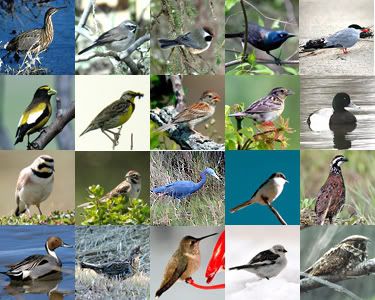 Top Row, left to right: American Bittern, Black-Throated Sparrow,Boreal Chickadee, Common Grackle, Common Tern; Row 2, left to right: Evening Grosbeak, Eastern Meadowlark, Field Sparrow, Grasshopper Sparrow, Greater Scaup; Row 3, left to right: Horned Lark, Lark Sparrow, Little Blue Heron, Loggerhead Shrike, Northern Bobwhite; Bottom Row: Northern Pintail, Ruffed Grouse, Rufous Hummingbird, Snow Bunting, Whip-poor-will
Top Row, left to right: American Bittern, Black-Throated Sparrow,Boreal Chickadee, Common Grackle, Common Tern; Row 2, left to right: Evening Grosbeak, Eastern Meadowlark, Field Sparrow, Grasshopper Sparrow, Greater Scaup; Row 3, left to right: Horned Lark, Lark Sparrow, Little Blue Heron, Loggerhead Shrike, Northern Bobwhite; Bottom Row: Northern Pintail, Ruffed Grouse, Rufous Hummingbird, Snow Bunting, Whip-poor-willThe NYT reports:
Spreading suburbs and large-scale farming are contributing to a precipitous decline in once common meadow birds like the Northern bobwhite, the Eastern meadowlark, the loggerhead shrike and the field sparrow, a report released yesterday by the Audubon Society said. [List of top 20 common birds in decline.]
Twenty common birds have lost more than half their populations in 40 years. The population of the bobwhite, a rotund robin-size bird that lives in meadows from the mid-Atlantic to the Plains, has dropped more than 80 percent, to 5.5 million from more than 31 million.
The evening grosbeak, with a range from northern New England to the Pacific Northwest, has declined 78 percent, to 3.8 million from 17 million.
The report covers a period when suburbs and exurbs were being carved out of Eastern and Midwestern farmlands and Southern wetlands. It also documents the loss of large numbers of Canadian and Arctic birds like the mallard-like greater scaup, the Northern pintail and the greater tern, all affected by a combination of climate change and development along lakes and rivers.
While the report, published in Audubon magazine has a national focus, it also gives state-by-state snapshots of declines in birds in 48 states where enough information is available.
“The song of Eastern meadowlarks used to be the soundtrack of summer,” said Scott Weidensaul, a naturalist and author born in eastern Pennsylvania who has reviewed the report. “Now it’s a rare thing. The landscape is changing. Farming is much more industrialized. Development is sprawling across these valleys.”
Although the declines since 1967 are steep, the overall populations of the meadow birds still number in the millions, or in the case of the scaup 300,000, making them too robust to qualify for protection under the Endangered Species Act.
The new analysis is the first of three reports. The next will look at birds that may need federal protection. The final installment will track the effects of climate change.
The changing bird demographics largely parallel the changes in the North American landscape wrought by people. In the Northeast, the reversion of fields to forests has hurt some field-dwelling species, and some forest-dwelling species have been hurt by the loss of woodland shrubs overbrowsed by deer.
The most common backyard birds like robins, cardinals and blue jays are thriving, though blue jay numbers have been cut somewhat by West Nile virus, said Greg Butcher, the author of the Audubon report.
The birds that have done best —perhaps too well, in the case of nonmigratory Canada geese — are those most at home in the world of manicured lawns and artificial lakes.
The report coincides with Congressional deliberation of measures like the farm bill, which includes some provisions to set aside agricultural land in conservation reserve programs. Those provisions are under pressure because of the demand for expanded land for corn crops to fuel the ethanol boom.
The report is based on a statistical analysis of two long-range bird censuses, one by the United States Geological Survey and one by Audubon.
Both surveys cover 300 species, said Mr. Butcher, the director of bird conservation at Audubon and a former director of bird population studies at the Cornell Ornithology Laboratory. About 550 are covered by one or the other.
The report has not been submitted for peer review, he said, but its methodology has been vetted in a peer-review process.
On the Audubon Society's website:
How Citizen Science Revealed the Problem
For the first time ever, this analysis combined data from the world’s longest-running uninterrupted bird census — Audubon’s Christmas Bird Count (CBC) — with information from the Breeding Bird Survey (BBS) to study how populations of all common North American species routinely encountered in these surveys have fared during the past 40 years. The CBC data are the product of swarms of volunteers —citizen scientists— who counted birds every winter over this period and submitted their reports to Audubon. The BBS is a standardized morning count of birds along roadsides organized by the U.S. Geological Survey and conducted by volunteers from May into July.

No comments:
Post a Comment